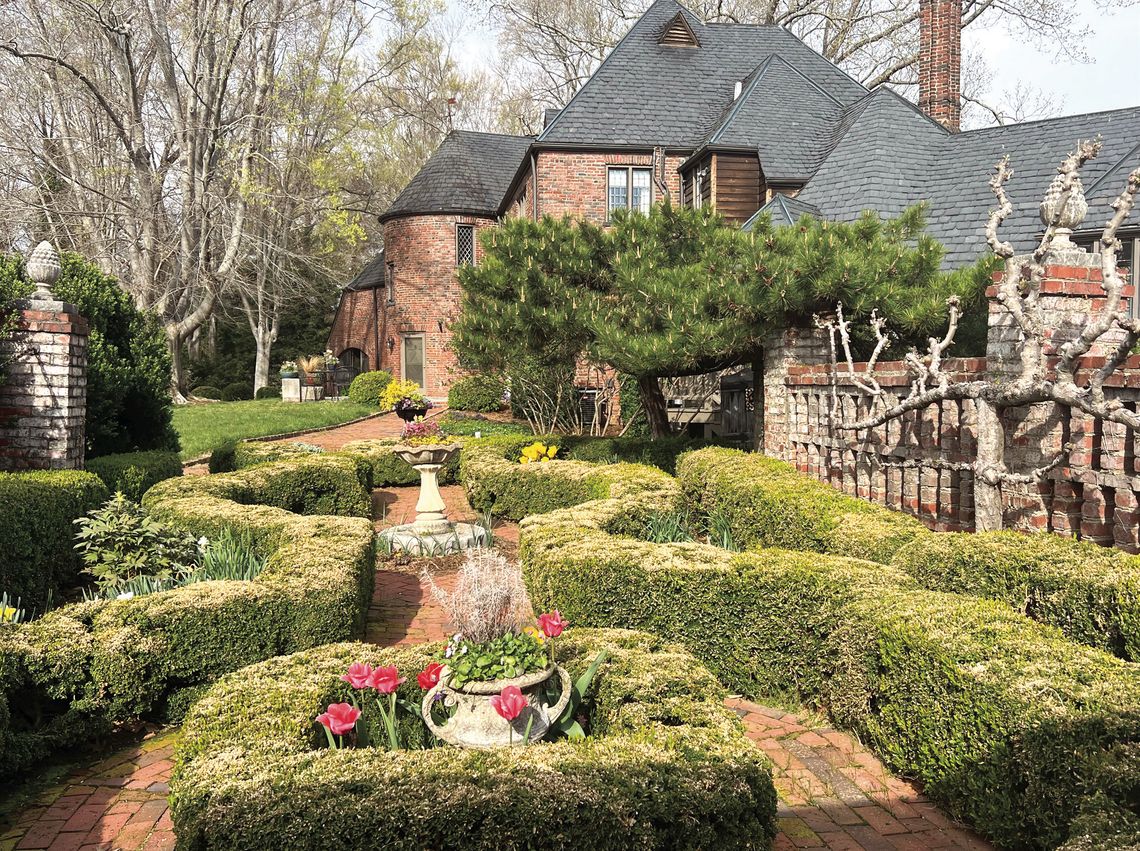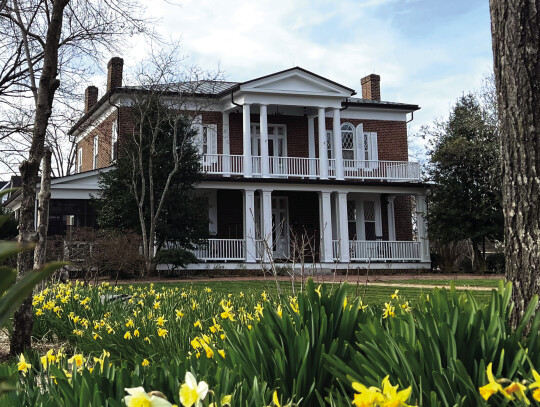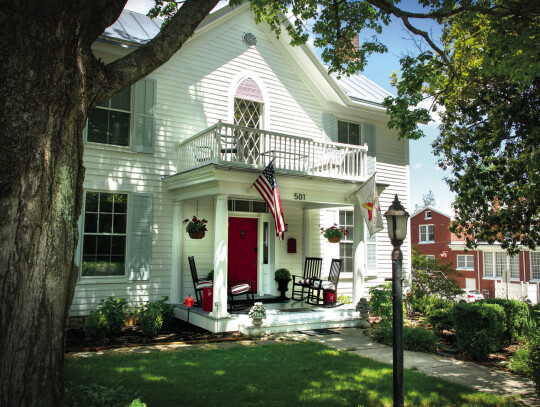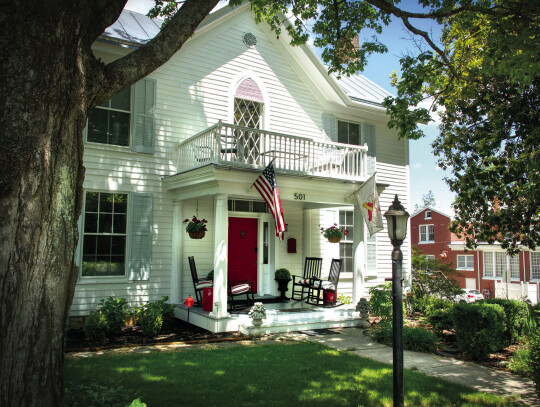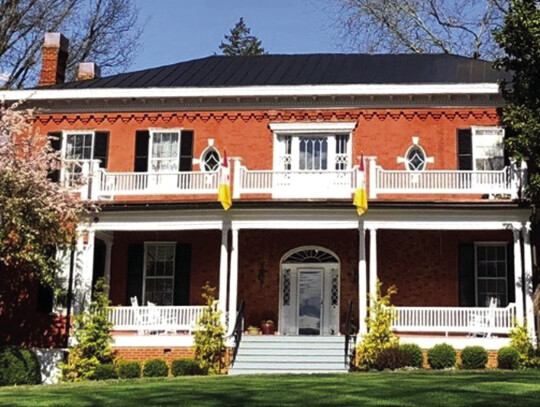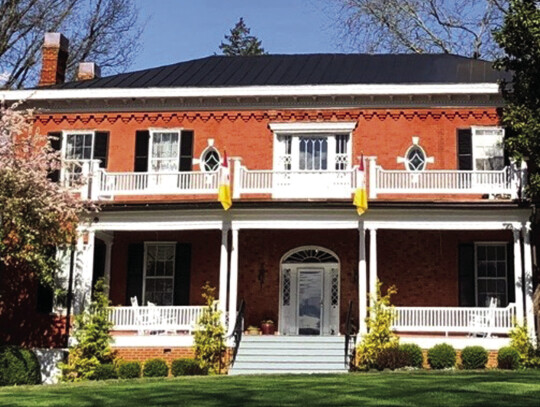Lexington’s Historic Garden Week tour this spring features a variety of private properties that display the owners’ commitment to preservation, environmentalism, and sustainability.
This tour is a combination of historic homes and gardens near downtown Lexington. Hosted by the Blue Ridge Garden Club, the tour takes place on Saturday, April 22, from 10 a.m. to 4 p.m. and features three houses and one garden.
Tickets can be purchased in advance online at https:// www.vagardenweek.org/tickets/ for $25.
Day-of-the-tour tickets will be available for $35 at the tour’s headquarters at the Lexington Visitor Center, 106 E. Washington St.
Area residents should start the tour at the Lexington Visitor Center and show their ticket order to pick up wristbands for access to tour properties.
Two of the properties, Mulberry Hill and the Belfield gardens, will be accessible by shuttle only from the Lexington Visitor Center.
Street parking will be available for 501 S. Main St. and 601 S. Main St.
Complimentary refreshments will be served at Mulberry Hill from 1 p.m. until 3 p.m.
Proceeds fund the restoration of historic gardens and landscapes in Virginia, as well as two research fellowships in landscape architecture.
This year celebrates the 90th anniversary of Historic Garden Week in Virginia.
The following properties are included on the tour.
Gardens of Belfield 116 Liberty Hall Road Shuttle only
A newly employed Washington and Lee University faculty member, Frank Gilliam, and his wife, Louise, purchased the two-and-onehalf acre property adjacent to Mulberry Hill. Following the completion of their Tudorstyle home, the gardens were begun.
The renowned landscape architect, Charles Freeman Gillette, was consulted for transforming the grounds into gardens. Gillette created a garden reflecting his style, which has been described as eclectic and architectonic.
A series of garden spaces or rooms were developed, one a formal boxwood garden leading from the residence to a stone shelter with a Canadian folk carving of The Annunciation as its back wall.
During the Gilliams’ 47 years at Belfield, they continued to develop the garden, creating a regional attraction. Louise Gilliam’s passion for gardens included serving as president of the Garden Club of Virginia from 1948 to 1950. The couple’s work in horticulture resulted in the 1960 Massie Medal for Distinguished Achievement from the Garden Club of Virginia.
In December 2009, a gift from an anonymous donor allowed Washington and Lee University to purchase Belfield. In 2014, thanks to additional gifts, extensive work was done to restore the neglected garden. Walkways were reset, mortar colors matched, and boxwoods preserved when possible. Daffodils, lilacs, and fern-leaf beeches are a few of the many horticultural features in inspiring settings at Belfield.
Sturdy shoes recommended. Shuttle only.
Mulberry Hill 115 Liberty Hall Road Shuttle Only
Mulberry Hill sits on a ridge on the northwest edge of Lexington’s city limits. The original acreage was purchased in 1777 by William Graham, the first rector of Liberty Hall Academy, now Washington and Lee University.
Twenty-two years later Graham sold 450 acres of his property to Andrew Reid, the first clerk of the court of Rockbridge County, who built a one-story, double-pile Flemish bond brick house. Reid was one of the wealthiest citizens in the area; the home he built was large for its time. It later became the foundation of today’s existing structure.
Reid’s 1815 records include 23 slaves; none of their houses remain.
Mulberry Hill was called a great mansion house known for its Georgian interior, created by Hessian builders. Reid’s son, Samuel McDowell Reid, inherited the house. A second story with a gable roof and spiral interior staircase was added in the mid-19th century. The change in architectural styles over the years can be seen with the first story’s Federal influence and the second story’s Italianate. The home was extensively renovated in the early 1900s. Added were a central transom doorway with flanking oval windows to the east exterior section, the hip roof, a rear kitchen, a rear bathroom “tower,” and a central front porch.
The boxwood garden was designed in the 1930s with a focus on Lexington’s iconic House Mountain. The colonnaded back porch and patio were begun in the 1950s and look out to the lawn with its mature trees and the boxwood garden. In 2004, the present owners, the Kappa Alpha Order and Educational Foundation (KAOEF), purchased the property from Mr. and Mrs. Lewis Tyree Jr. whose family had owned the property since 1931. Shuttle only.
501 South Main Street
Constructed in 1868, the home was originally the residence of prominent local builder John Gwynn Pole. More recently known as the Magnolia House Bed and Breakfast, it has had several different owners. After being vacant for almost 18 months, it was purchased in 2019 by its present owners.
The home sits on a coursed limestone foundation and features weatherboard siding, original windows, and peaked lintels. A portico with fluted Doric columns leads to a distinctive Gothic doorway beneath a steep center front gable. There are four principal rooms on each floor and a total of eight fireplaces, each with handcrafted 18th-century mantels. Handcrafted woodwork, heart of pine flooring, and plaster walls and ceilings are present in the home with heat from ornate cast-iron radiators.
One of the upstairs bedrooms features an inscription carved into the window glass from Alpha Tau Omega members. This fraternity was founded in 1865 at Virginia Military Institute as a faith-based organization to help individuals returning from the Civil War. The home is now owned by a VMI graduate who is the director of Fellowship of Christian Athletes at VMI.
Situated on a prime corner lot on South Main Street, the magnolia tree in the front is a focal point of the property. The owners, Lisa and Alan Soltis, are particularly excited about the peonies, boxwood, azaleas, iris, hydrangeas, and a recently planted Cryptomeria japonica.
Stonegate 601 S. Main Street
This historic home became known as Stonegate because of the formal, stone entrance for carriages and horses off Main Street. The original home, which is now the kitchen, was probably built in 1832 for the James Campbell family.
James Campbell died in the 1850s, and the Campbell farm was sold to E.F Payton and W.G White. The house stood on 175 acres. The two men then subdivided the farm and “offered for sale at public auction” much of the subdivision. The lot containing the “dwelling house” was purchased by the Rev. William M. McElwee, who built what is now the main house in 1859. He was the owner throughout the Civil War.
In 1865, General Robert E. Lee accepted the invitation to become president of Washington College, now Washington and Lee University. Lee moved to Lexington and would visit the Reverend McElwee, sometimes staying late into the afternoon. As word circulated that the general was present at Stonegate, great crowds would assemble in front of the house to watch him leave. Lee liked to keep his privacy and would leave the house through a trap door in the floor of the dining room, which would take him into the basement and out the back of the home, avoiding the crowds. The trapdoor remains a feature in the dining room.
Margaret and Derek Hutton purchased Stonegate in March 2022 and have turned it into an elegant guesthouse with gardens.
.jpg)
